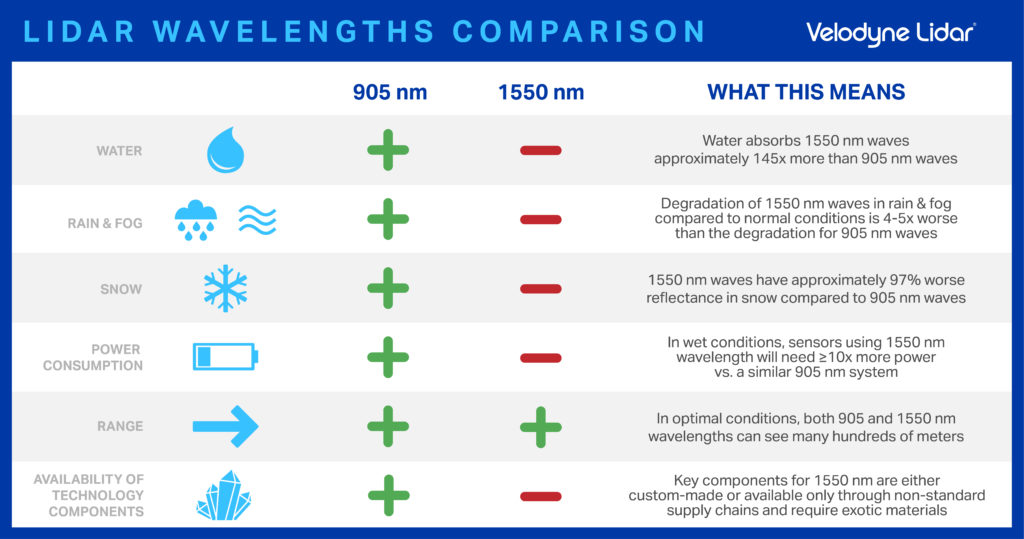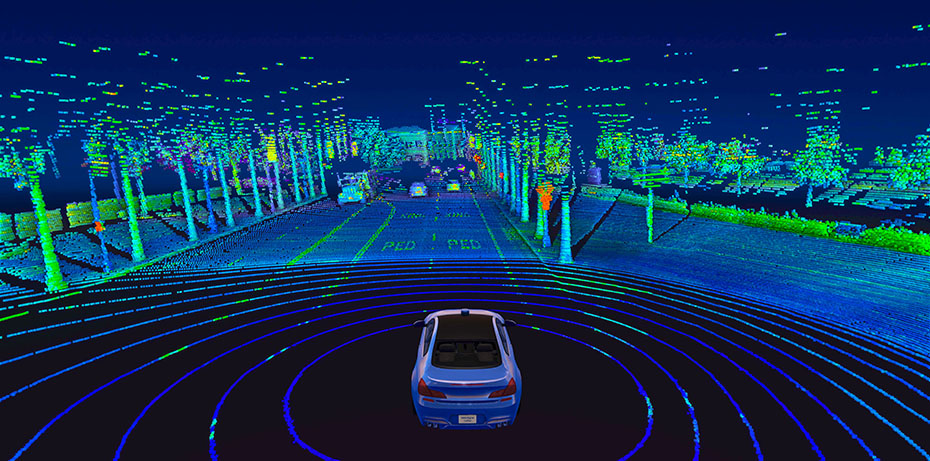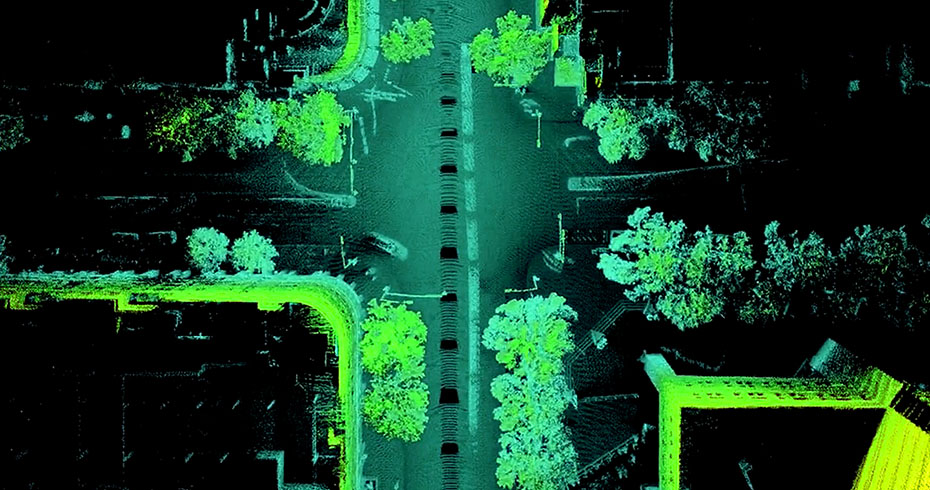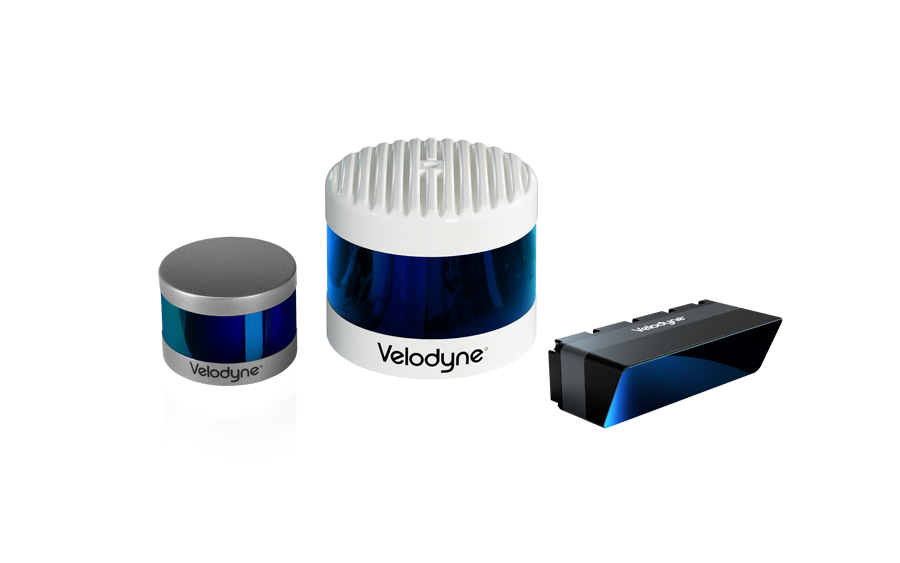[Article Updated 3/26/2021]

Lidar is an acronym for “Light Detection And Ranging.” It is sometimes called “laser scanning” or “3D scanning.” The technology uses laser beams to create a 3D representation of the surveyed environment. To break this down: lidar technology commonly uses pulsed lasers to measure the distance to an object. The sensor bounces up to millions of laser pulses per second off surrounding objects. Based on the pulses’ time-of-flight, distance to the object is calculated in real time. Depending on the lidar sensor, tens of millions of data points can be generated to produce a point cloud, which is a “3D map” of the surroundings.

Current state-of-the-art lidar systems largely employ one of two lidar wavelengths: 905 nanometers (nm) and 1550 nm. Each wavelength presents engineers with tradeoffs for consideration, including the effects of water on signal integrity, power consumption and the availability of sensor components.
All commercially sold lidar products must achieve eye-safety certification via compliance with the U.S. Food & Drug Administration (FDA) eye-safety performance standard, which conforms with the International Electrotechnical Commission (“IEC”) 60825 standard. If sensors are designed to meet eye safety standards, both wavelengths can be used safely. All of Velodyne Lidar’s sensors operate at 905 nm at Class 1 level, which is the safest level.

Water can affect lidar signal integrity. This is an important issue for automotive lidar systems given the adverse weather conditions vehicles encounter on the road. Pulsed time-of-flight sensors operating at the 1550 nm wavelength may experience significant signal degradation in rainy, foggy and snowy conditions, thereby degrading data returns used to create point clouds and safely navigate the surroundings.i
Compared with 905 nm, 1550 nm light has a relatively high attenuation coefficient causing strong absorption leading to rapid reduction of signal strength with distance, when penetrating water. In fact, when passing through water, the attenuation coefficient of 1550 nm waves is ~145x higher than that of 905 nm waves.ii
As a result, compared to normal conditions, the level of degradation experienced by 1550 nm signals when transmitted through rain and fog is about 4-5 times worse than that experienced by 905nm wavelength signals.iii
When transmitted through snow and ice, relative degradation of 1550 nm signals is also remarkable, more than 90% worse than that experienced by 905 nm signals.iv These characteristics of 1550 nm light could have significant impact on the quality of perception that lidar sensors using this wavelength are able to produce during rainy, foggy and snowy weather. Moreover, the significant impact of signal absorption on 1550 nm lidar performance is not limited to the duration of weather events but applies to any surface that is wet or covered in ice or snow. For 1550 nm light, reflectance on wet surfaces could drop as much as 60% compared to normal. In the case of 905 nm, the decrease is far less (15%).v

These results demonstrate that automotive and aerial lidar sensors using 1550 nm wavelength are going to face significant challenges when moisture, snow and ice are present. This raises major questions about the ability of 1550 nm lidar to reliably perceive objects and ensure safe navigation in the required range of environments and conditions.
It is therefore not surprising that scientists who conducted a comparison of 905 nm and 1550 nm technologies concluded that the 905 nm wavelength “seems to be a much more weather-proof solution and, thus recommended for applications [in which] all types of environmental conditions have to be taken into account.”vi
Additionally, a National Oceanic and Atmospheric Administration (NOAA) report on lidar for remote sensing and coastal mapping recommended that 1550 nm lasers not be used, citing their poor performance in wet conditions.vii
The degradation in rain, snow and fog conditions of 1550 nm wavelength means lidar sensors using 1550 nm will need ≥ 10x more power as compared to a similar 905 nm system. This could create the need for larger systems, including additional power and cooling components, which must be stored in a vehicle (most likely in the trunk, due to size). Taking this approach makes it harder to scale from a lab-instrument-grade technology to large commercial volumes to support automakers.
The automaker industry is rapidly converting their product lines to electrical vehicles. So, sensors with high power requirements, such as those using 1550 nm wavelengths, will be less attractive to use in electric vehicles. Moreover, high power consumption might lead to excess heat generation that requires active cooling systems, which further add to cost and complexity.
In most cases, both 905 and 1550 wavelengths are able to see many hundreds of meters away in optimal conditions. Given 1550 nm wavelength characteristics, one could increase power output in order to gain additional range at the obvious expense of draining the power source more quickly and generating additional power-sapping heat in the system. However, most people encounter adverse weather conditions on a regular basis, and according to the simple laws of physics, 905 nm wavelengths maintain their nominal parameters far better than 1550 nm wavelengths in those conditions.viii
The availability of technology components is a critical consideration when choosing between 1550 nm and 905 nm wavelengths. Currently, key components for 1550 nm systems are either custom-made or available only through non-standard supply chains. They also require exotic materials to manufacture.

Conversely, 905 nm lidar systems can be built using widely available, lower-cost CMOS technology, as noted in Electronic Specifier . Given their more widespread deployment, 905 nm lidar systems have a well-established ecosystem that provides standard, off-the-shelf components.
As engineers assess lidar technologies, it is important to examine foundational architecture characteristics such as wavelength. By looking at wavelength through the lenses of safety, water absorption, power consumption and component supply chains, it is clear that 905 nm lidar technology is the best fit for engineering, development and production needs of autonomous vehicles and Advanced Driver-Assistance Systems (ADAS).
iWojtanowski, Jacek, Marek Zygmunt, Mirosława Kaszczuk, Z. Mierczyk, and Michal Muzal. “Comparison of 905 nm and 1550 nm semiconductor laser rangefinders’ performance deterioration due to adverse environmental conditions.” Opto-Electronics Review 22, no. 3 (2014): 183-190.
iiWojtanowski, et. al., (2014).
iiiWojtanowski, et. al., (2014).
ivWarren, S. G., “Optical properties of snow, Review of Geophysics,” Vol. 20 Issue 1, 1982: 67– 89.
vWojtanowski, et. al., (2014).
viWojtanowski, et. al., (2014).
viiHahn, John, “High-Level Analysis & Scientific Assessment of the Utility of Applying a 1.5Micron-Range Wavelength Laser Based Airborne LiDAR System to Shoreline Mapping,” August, 2009. Cited in “Light Detection and Ranging (LIDAR) Requirements,” National Oceanic and Atmospheric Administration, December, 2009.
viiiWojtanowski, et. al., (2014).

Velodyne Lidar (Nasdaq: VLDR, VLDRW) ushered in a new era of autonomous technology with the invention of real-time surround view lidar sensors. Velodyne, a global leader in lidar, is known for its broad portfolio of breakthrough lidar technologies. Velodyne’s revolutionary sensor and software solutions provide flexibility, quality and performance to meet the needs of a wide range of industries, including robotics, industrial, intelligent infrastructure, autonomous vehicles and advanced driver assistance systems (ADAS). Through continuous innovation, Velodyne strives to transform lives and communities by advancing safer mobility for all.